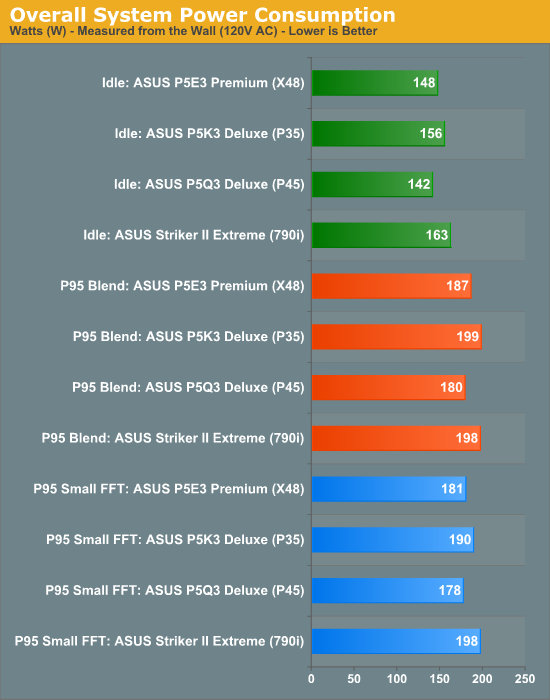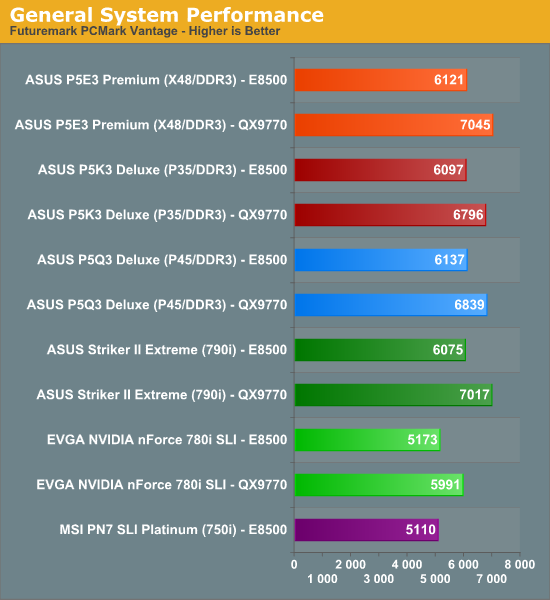ASUS P5Q3 Deluxe: An Early Preview of P45 Express Performance
by Kris Boughton on May 13, 2008 2:00 PM EST- Posted in
- Motherboards
Test System Configuration & General System Performance (PCMark Vantage)
| Test System Configurations | |
| Motherboards |
ASUS Striker II Extreme (NVIDIA nForce 790i-Ultra SPP and 570 MCP)
EVGA NVIDIA nForce 780i SLI MSI PN7 Platinum (NVIDIA nForce 750i SPP) ASUS P5E3 Premium (Intel X48 Experss MCH and ICH9R) ASUS P5K3 Deluxe (Intel P35 Experss MCH and ICH9R) ASUS P5Q3 Deluxe (Intel P45 Express MCH and ICH10R) |
| Processors |
Intel Core 2 Duo E8500 (ES)
Dual-core, 3.16GHz, 6MB Unified L2 Cache, 9.5x Multiplier, 1333 FSB Intel Core 2 Extreme QX9770 (ES) Quad-core, 3.20GHz, 2x6MB Unified L2 Cache, 8.0x Multiplier, 1600 FSB |
| Memory |
4x1GB OCZ DDR3 PC3-14400 Platinum Edition
4x1GB OCZ DDR2 PC2-8000 Platinum Extreme Edition |
| Graphics Card | ASUS EN8800GTS TOP 512MB (G92) |
| Cooling | D-tek FuZion CPU block, EK-FC88 GT/GTS full coverage GPU blocks, ThermoChill PA120.3 radiator, 3x SUNON KDE1212PMB3-6A 120x38mm fans, Laing D5 pump, 1/2" ID (3/4" OD) Tygon tubing |
| Power Supply | OCZ EvoStream 600W Modular PSU |
| Hard Drive | Western Digital WD250YS, 250GB, 7200RPM, SATA 3Gb/s, 16MB buffer |
| Video Driver | NVIDIA 169.25 (latest WHQL) |
| Operating System | Windows Vista Ultimate (x64) SP1 with DirectX 10.1 |
In order to compare the relative performance of base gaming rigs built using each chipset, we assembled identically configured systems in which the only component that was varied was the motherboard. All other components - including the CPU, memory modules (whenever possible), PSU, and graphics card - were simply transferred from one system to the next. An ASUS Striker II Extreme was used for the 790i base, an ASUS P5E3 Premium represented our choice in X48 motherboards, the ASUS P5K3 Deluxe for the P35 and the new contender, the ASUS P5Q3 Deluxe, provided the platform for testing the P45 chipset.
System power was measured at the wall, and thus our reported results do not make use of any power efficiency correction factor that would be helpful in more accurate relating actual power draw to typically system power consumption. This is an unimportant detail as these findings are merely intended to provide a means for differentiating one chipset from the next.
Data was collected after booting each system and allowing sufficient time for all OS activity to die down (about 7 minutes) and after total system load was noted to have stabilized for at least 30 seconds while stressing the CPU using a multi-instancing, 64-bit build of Prime95. "Small FFTs" were tested in order to create maximum CPU load while the "Blend" option was used to stress the memory subsystem (and thus the MCH).

At idle the P5Q3 Deluxe (P45) shows a savings of about 6W on average beyond the already low power usage of our X48 test system. Of these results, perhaps the power consumption figures for the P35 board were the most surprising - despite running hotter even the X48 system showed better efficiency than the older P35 chipset. The Striker II Extreme, with the NVIDIA nForce 790i-Ultra chipset, ranked a distant fourth, consuming 7W more than P35 and proving once again that power efficiency often takes a back seat to performance when dealing with high-end systems.
Loading each system by running Prime95 in "Small FFT" mode results in near identical power consumption figures for the P45 and X48 systems. The NVIDIA 790i-based board and the P5K3 (P35) trailed the pack, drawing over 10% more power clock-for-clock than either board featuring a 4-series Intel chipset.
Finally, "Blend" mode shows the P45 board providing quite interesting results - our wall power meter registered little difference between this mode and "Small FFTs". This suggests that the P45 chipset's prefetch algorithms are tuned for exceptionally low power operation even when memory intensive applications call for heavy access to data stored in main system memory. X48 is a stark contrast to this as programs that rely on heavy traffic to system memory consistently result in higher system power consumption.

We ran a just enough of PCMark Vantage as necessary for the generation of proper total system score. As a rule of thumb, DDR3 systems generally out-score their DDR2 counterparts by at least 1000 PCMarks, regardless of tuning. When placed side-by-side P35, P45 and X48 look a lot like NVIDIA's 790i-Ultra when it comes to measuring overall system productivity.
One of the useful aspects of PCMark Vantage is that these figures can serve as baseline results for comparing our test systems to yours at home. Try to match your components as closely as possible to ours, with the exception of your motherboard, when contrasting your results with those shown here.










30 Comments
View All Comments
dingetje - Tuesday, May 13, 2008 - link
a p45 shootout article would be awesome.i won't buy asus anymore because of their EPU scam, but am very interested in the gigabyte and msi p45 offerings
Hxx - Wednesday, May 14, 2008 - link
Asus = EPU scam, Gigabyte = dynamic energy saver scam. Unless your running your system at stock speeds, these features are useless, which brings out the following question? why are these 2 embedded in high end motherboards?Hulk - Tuesday, May 13, 2008 - link
I've written this before but a lot of people (like myself) might be considering this board as a big upgrade from an older board, like my current P5B Deluxe rig. Please include some "legacy" benchmarks so we can see if the performance improvements are worth the dimes.hansmuff - Tuesday, May 13, 2008 - link
Certainly the P35 is mature by now and will be eclipsed, but I'd like to see a consideration of performance/$.A good P35 board is $120, 4GB of name brand DDR2-800 with an 8GB option (2x2GB) is $85. I can't even buy this P45 for those two combined, so DDR3 cost really comes into play.
Frumious1 - Tuesday, May 13, 2008 - link
Well, you can't even buy any P45 boards right now, so it's a bit premature to discuss retail prices. This particular board is DDR3, so for budget-conscious buyers it would probably be a poor choice. ASUS will have a DDR2 model as well, and so will other companies. How much will those boards cost and how will they perform relative to, say, X38 DDR2 boards? Or P965, 975X, and P35 DDR2 boards? Those are all things we will hopefully examine in a future article. (Not being the motherboard reviewer, I can't make any promises. :))Hxx - Wednesday, May 14, 2008 - link
This board doesn't look "mainstream" to me for a 250 dollar board. I know that intel boards can go as high as 500 bucks a piece but a mainstream board is a stripped down of all the features such as dual ethernet, wireless build in, etc, and this board has it all, except maybe watercooling blocks. But anyway, just like the author stated, a major shift to a different socket type and processing power si drawing near, hopefully by the end of this year aka nehalem, which will pretty much make the x38/48 and p35/45 series become obsolete. So this board is definitely not futureproof. Having said that, most enthusiast/mainstream users will skip this product and look further ahead to the coming up nehalem processors. As for people looking to upgrade or building a new system, P35 can be had for less than $100 without sacrificing too much performance, or x38 for under 200 for crossfire purposes.P45 will only increase Intel's revenues without bringing anything new or worthy of attention to us, the consumers.
JarredWalton - Wednesday, May 14, 2008 - link
$249 as an estimated price prior to launch is not indicative of the market as a whole. I imagine we'll see P45 boards at much more reasonable prices - they should only carry a small premium over P35 boards really.You can also see updated results with P35 performance in the charts now, and from that it's quite clear that P45 isn't a major leap forward. We'll have to wait for further tests on stuff like CrossFire, as that might show more of an advantage, but unless P45 comes in at a price lower than X38 it won't really be a huge chipset launch. Luckily, I expect we will see $150 and lower priced P45 boards - just probably not from ASUS. ;-)
Hxx - Wednesday, May 14, 2008 - link
Wow, performance difference between p45 and p35 is so small it's scary. One might state that P45 is just a refresh of its older brother, which is not.Frumious1 - Tuesday, May 13, 2008 - link
Edit: *they* will hopefully examine. Whatever. I know that's what I want to see benchmarked.goosemilk - Tuesday, May 13, 2008 - link
Does this board support Crossfire and SLi?